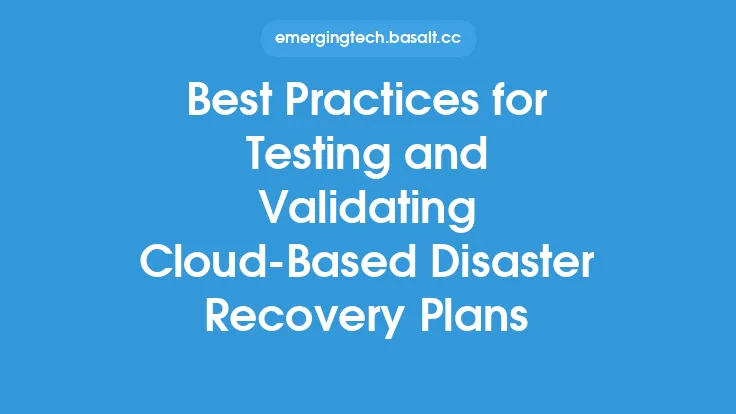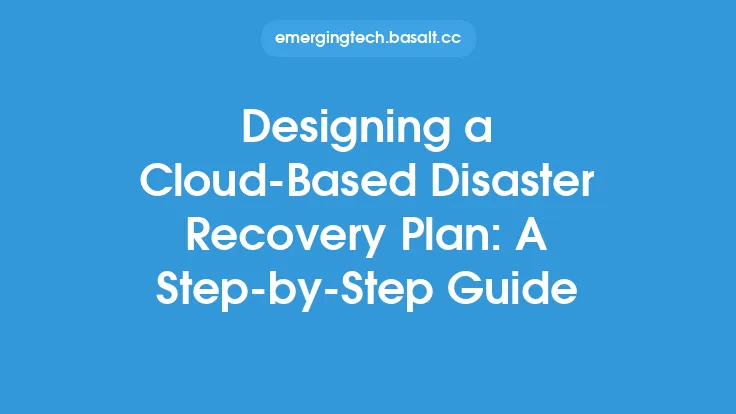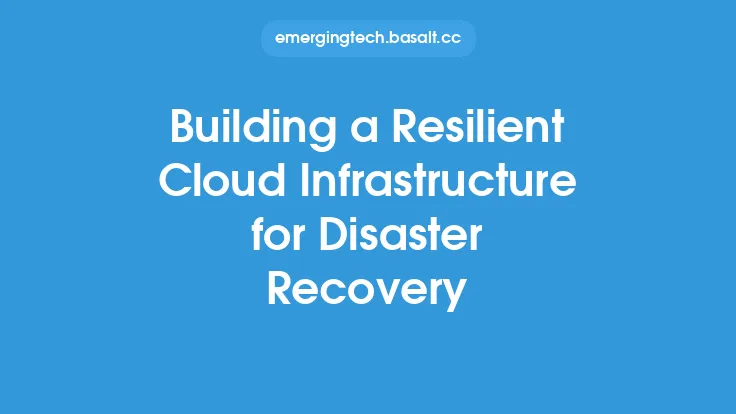When it comes to protecting data in the event of a disaster, cloud-based disaster recovery has become an essential consideration for organizations of all sizes. The cloud provides a scalable, flexible, and cost-effective way to ensure business continuity in the face of unexpected events such as natural disasters, cyberattacks, or equipment failures. However, implementing a cloud-based disaster recovery solution requires careful planning and consideration of several key factors.
Introduction to Cloud-Based Disaster Recovery
Cloud-based disaster recovery involves replicating data and applications to a cloud environment, where they can be quickly restored in the event of a disaster. This approach provides several benefits, including reduced infrastructure costs, increased scalability, and improved reliability. Cloud-based disaster recovery solutions can be implemented in a variety of ways, including through the use of cloud storage, cloud-based backup and recovery services, and disaster recovery as a service (DRaaS) providers.
Key Considerations for Data Protection
When implementing a cloud-based disaster recovery solution, there are several key considerations for data protection that must be taken into account. These include data security, data integrity, and data availability. Data security is critical, as sensitive data must be protected from unauthorized access and breaches. This can be achieved through the use of encryption, access controls, and secure authentication protocols. Data integrity is also essential, as data must be accurate and consistent across all systems and applications. This can be ensured through the use of data validation and verification processes. Finally, data availability is critical, as data must be accessible and usable in the event of a disaster. This can be achieved through the use of redundant systems, backup and recovery processes, and disaster recovery planning.
Cloud Storage Options for Disaster Recovery
There are several cloud storage options available for disaster recovery, each with its own strengths and weaknesses. These include public cloud storage providers such as Amazon S3, Microsoft Azure Blob Storage, and Google Cloud Storage, as well as private cloud storage solutions such as OpenStack and CloudStack. Public cloud storage providers offer scalability, flexibility, and cost-effectiveness, but may also introduce security and compliance risks. Private cloud storage solutions, on the other hand, provide greater control and security, but may also be more expensive and complex to implement.
Cloud-Based Backup and Recovery Services
Cloud-based backup and recovery services provide a convenient and cost-effective way to protect data in the cloud. These services typically involve automating the backup process, storing data in a secure cloud environment, and providing rapid recovery options in the event of a disaster. Cloud-based backup and recovery services can be implemented through a variety of providers, including Veeam, Commvault, and Veritas. When selecting a cloud-based backup and recovery service, it is essential to consider factors such as data security, data integrity, and recovery time objectives (RTOs).
Disaster Recovery as a Service (DRaaS) Providers
Disaster recovery as a service (DRaaS) providers offer a comprehensive disaster recovery solution that includes cloud storage, backup and recovery services, and disaster recovery planning. DRaaS providers typically provide a managed service, where the provider is responsible for monitoring, maintaining, and recovering data in the event of a disaster. DRaaS providers can be particularly useful for organizations that lack the resources or expertise to implement a disaster recovery solution on their own. When selecting a DRaaS provider, it is essential to consider factors such as service level agreements (SLAs), recovery time objectives (RTOs), and recovery point objectives (RPOs).
Technical Requirements for Cloud-Based Disaster Recovery
Implementing a cloud-based disaster recovery solution requires careful consideration of several technical requirements. These include network bandwidth, latency, and throughput, as well as storage capacity, processing power, and memory. Network bandwidth and latency are critical, as they can impact the speed and efficiency of data transfer and recovery. Storage capacity, processing power, and memory are also essential, as they can impact the performance and scalability of the disaster recovery solution. Additionally, technical requirements such as data encryption, access controls, and secure authentication protocols must be considered to ensure the security and integrity of data.
Best Practices for Implementing Cloud-Based Disaster Recovery
When implementing a cloud-based disaster recovery solution, there are several best practices that should be followed. These include developing a comprehensive disaster recovery plan, testing and validating the disaster recovery solution, and monitoring and maintaining the solution on an ongoing basis. A comprehensive disaster recovery plan should include procedures for data backup and recovery, system restoration, and business continuity. Testing and validation are critical, as they ensure that the disaster recovery solution is functioning correctly and can meet recovery time objectives (RTOs) and recovery point objectives (RPOs). Ongoing monitoring and maintenance are also essential, as they ensure that the disaster recovery solution remains up-to-date and effective.
Conclusion
Cloud-based disaster recovery provides a scalable, flexible, and cost-effective way to protect data in the event of a disaster. However, implementing a cloud-based disaster recovery solution requires careful consideration of several key factors, including data security, data integrity, and data availability. By understanding the key considerations for data protection, cloud storage options, cloud-based backup and recovery services, DRaaS providers, technical requirements, and best practices for implementation, organizations can ensure that their data is protected and their business can continue to operate in the event of a disaster.





